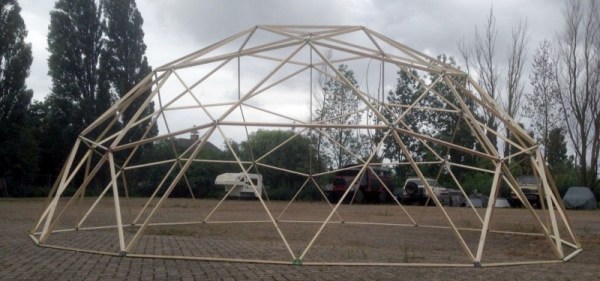[Morphje] has always wanted to build a geodesic dome. The shape and design, and the possibility of building one with basic materials interest him. So with the help of a few friends to erect the finished dome, he set about realising his ambition by building a 9.1 metre diameter structure.
The action took place at Rev Space (Dutch language site), the hackspace in The Hague, Netherlands. [Morphje] first had to create a huge number of wooden struts, each with a piece of tube hammered down to a flat lug set in each end, and with a collar on the outside of the strut to prevent it from splitting. The action of flattening the ends of hundreds of pieces of tube is a fairly simple process if you own a hefty fly press with the correct tooling set up in it, but [Morphje] didn’t have that luxury, and had to hammer each one flat by hand.
The struts are then bolted together by those flattened tube lugs into triangular sections, and those triangles are further bolted together into the final dome. Or that’s the theory. In the video below you can see they make an aborted start assembling the dome from the outside inwards, before changing tack to assemble it from the roof downwards.
This project is still a work-in-progress, [Morphje] has only assembled the frame of the dome and it has no covering or door as yet. But it’s still a build worth following, and we look forward to seeing the finished dome at one or other of the European maker events in the summer.
Continue reading “Geodesic Dome Build At Rev Space Den Haag”

















